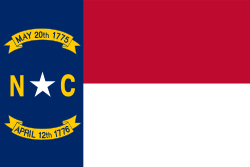Alamance County
| Alamance County | ||
| County | ||
Alamance Countys domstolshus i Graham. | ||
| ||
| Land | ||
|---|---|---|
| Delstat | ||
| Huvudort | Graham | |
| Area | 1 126 km² (2010)[1] | |
| - land | 1 098 km² (98%) | |
| - vatten | 28 km² (2%) | |
| Folkmängd | 151 131 (2010)[2] | |
| Befolkningstäthet | 138 invånare/km² | |
| Grundat | 1849 | |
| Tidszon | EST (UTC-5) | |
| - sommartid | EDT (UTC-4) | |
| FIPS-kod | 37001 | |
| Geonames | 4452290 | |
Läge i delstaten North Carolina. | ||
Delstatens läge i USA. | ||
| Fotnoter: Naco - Find a county | ||
Alamance County är ett administrativt område i delstaten North Carolina, USA, med 151 131 invånare. Den administrativa huvudorten (county seat) är Graham.
Geografi
Enligt United States Census Bureau har countyt en total area på 1 127 km². 1 114 km² av den arean är land och 13 km² är vatten.
Angränsande countyn
- Caswell County, North Carolina - nord
- Orange County, North Carolina - öst
- Rockingham County, North Carolina - nordväst
- Chatham County, North Carolina - syd
- Randolph County, North Carolina - sydväst
- Guilford County, North Carolina - väst
Städer och samhällen
- Alamance
- Altamahaw
- Burlington (delvis i Guilford County)
- Elon
- Gibsonville (delvis i Guilford County)
- Glen Raven
- Graham (huvudort)
- Green Level
- Haw River
- Mebane (delvis i Orange County)
- Ossipee
- Saxapahaw
- Swepsonville
- Woodlawn
Källor
- ^ ”2010 Census U.S. Gazetteer Files for Counties”. U.S. Census Bureau. Arkiverad från originalet den 5 juli 2012. https://www.webcitation.org/68vYLbou5?url=http://www.census.gov/geo/www/gazetteer/files/Gaz_counties_national.txt. Läst 5 juli 2012.
- ^ ”State & County QuickFacts, Alamance County, North Carolina” (på engelska). U.S. Census Bureau. Arkiverad från originalet den 6 juli 2011. https://www.webcitation.org/5zyhsi9Kb?url=http://quickfacts.census.gov/qfd/states/37/37001.html. Läst 6 juli 2011.
|
Media som används på denna webbplats
Författare/Upphovsman: Warren LeMay, Licens: CC BY-SA 4.0
The Alamance County Courthouse is a Classical Revival-style structure located at the center of the downtown business district in Graham, North Carolina, and was constructed in 1924 to replace an earlier courthouse.
Författare/Upphovsman: This version: uploader
Base versions this one is derived from: originally created by en:User:Wapcaplet, Licens: CC BY 2.0
Map of USA with North Carolina highlighted
This is a locator map showing Alamance County in North Carolina. For more information, see Commons:United States county locator maps.
The flag of Alamance County, North Carolina, was designed in 1973 by a County Employee on request from a local resident who got the idea from her teenaged son, who saw a new flagpole going up at a local miniature golf course. The design was approved by the county commissioners in May 1974, along with a request for flags to be printed. According to county historical records, it was the first County Flag in North Carolina.
According to the minutes of the commissioners meeting, the colors of the flag match the colors of the North Carolina State Flag. The flag has a field of blue having the county seal as the center emblem, and having the following charges in each quarter canton, beginning in the top-left and going clockwise: a book and spectacles representing education, an amphitheater representing drama, a plow with a bird representing agriculture, and a factory building representing industry.
Due to printing difficulties (most likely to save on printing costs), this version of the flag has never been printed. The commissioners approved an exception that would allow the flag to be printed in blue and white.
The actual printed flag came out differently than was approved by the commissioners. The version that was printed in 1974/75 (in time for the national bicentennial) and reprinted again in the early 1990's (in time for Alamance County's Sesquicentennial in 1994) had 2 major changes from the approved design. First - the flag was a much lighter blue than was approved (it does not match the blue in the North Carolina State Flag). Secondly, the factory in the bottom left canton was printed backwards. This reversal seems to be due to a decision to have the reverse side of the flag printed to mirror the charges on the obverse. The obverse factory was printed on the reverse side and vice-versa.








